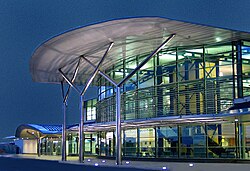Road
Road transport is the primary form of both private and public transport in Guernsey.
Main roads and lanes


Traffic in Guernsey drives on the left. Roads are generally narrow, with an all-island speed limit of 35 miles per hour (56 km/h); however, lower speed limits apply on certain roads. There are seasonal speed limit changes that see the speed limit of 35 miles per hour reduced to 25 miles per hour (40 km/h) on some coast roads during the summer months. [1] Some smaller roads have a recommended speed of 15 miles per hour (24 km/h), not enforced legally. These roads are designated as Ruette Tranquille. [2]
Most road markings are the same as the UK, with the exception of:
- A yellow line across the exit of a minor road means stop and give way to traffic on the major road. A yellow arrow painted on the road warns of a yellow stop line ahead.
- Junctions marked filter-in-turn. At these junctions, all directions have equal priority.
- Yellow kerb-side no stopping lines are single lines and mean you must not stop for any reason other than to avoid an accident.
Driving laws

Driving laws in Guernsey are the United Kingdom Highway Code, supplemented by the Guernsey Highway Code. [3]
Number plates in Guernsey became legal in 1908. Guernsey plates consist of up to five digits, with no letters, while Alderney uses 'AY', followed by four digits. [4] An oval containing the letters GBG (Great Britain and Northern Ireland – Guernsey), the island's international vehicle registration code, is sometimes included. [5]
Motor tax was abolished in Guernsey from 1 January 2008. Vehicle registration plates in Guernsey carry between one and five numerals only; the international identification sticker/plate is "GBG".
Drink-driving is illegal in Guernsey. Police use breathalyser tests during spot checks and a person is guilty if there is over 35 microgrammes of alcohol per 100 ml breath. [6]
Sark and Herm ban motor vehicles other than tractors from their roads.
Cycling

Cycling is encouraged in Guernsey, and there are various cycle routes and paths on the island, including a dedicated cycle route that runs along the island's east coast between Bulwer Avenue in St Sampson and North Beach in St Peter Port, with shared pedestrian usage. There are other routes in the north of the island. [7]
Bus
Guernsey's bus network has been operated by Stagecoach South West on behalf of the States of Guernsey's Committee for the Environment and Infrastructure since April 2025. [8] The service is currently branded as Buses.gg, with all service routes operating to and from the Town Terminus bus station in St Peter Port. 28 public routes and 24 school routes are run, with routes 91 and 92 forming a complete circuit of the island. [9]
Vehicles used are based on buses used in the UK but with a slightly narrower construction, to allow them to circulate on the island's narrow roads, with the legal limit of 2.31 meters (7' 6¾"). Several narrower (and shorter) StreetVibe buses arrived from May 2017 onwards. [10]
Most bus journeys have a fixed single fare price of £1.60 per journey; [11] however, one free transfer is permitted if a change buses is needed in order to complete the journey. After 9pm, limited night services operate a flat £5 fare and 1-day and 2-day unlimited travel passes are available. Payments can only be made by contactless or by 'Puffinpass'; however, cash payments are accepted at the Town Terminus Shop for top ups and the purchase of unlimited travel passes. The Puffinpass offers discounted single fares for daytime journeys in the form of Pay As You Go, unlimited weekly travel passes, student passes for ages 5–16, concession cards for ages 65+ and family travel passes. Residents in possession of a concessionary or student Puffinpass travel for free on all daytime services. Children under the age of 5 travel for free.
1.65m journeys were taken in 2016. [12] Bus usage increased year on year, reaching a record high of 2 million journeys in 2019. However, usage subsequently fell due to the COVID-19 pandemic. In March 2023, monthly usage was higher than pre-pandemic levels for the first time. [13]
There are no bus services in Herm or Alderney. However, there is a 'tractor bus' ferrying passengers up Harbour Hill from the harbour to the Avenue in Sark.
Taxis
Guernsey has a regulated, licensed taxi service based at ranks in central St Peter Port, St Sampson and at Guernsey Airport. Taxis can also be booked by telephone.
Accessible taxis capable of transporting a wheelchair passenger and with improved lighting to assist people who may have a visual impairment are available.
Alderney also has a regulated, licensed taxi service based at a rank at Alderney Airport where there are dedicated taxi phone lines.
There is no taxi service on Herm or Sark.
Carbon output
With effect from 2030, the sale of new combustion engine cars will be banned, which forms part of the net-zero climate change plan. [14]


